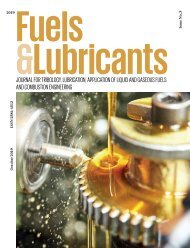Fuels & Lubricants Magazine
Issue No. 2, June 2018
Issue No. 2, June 2018
Create successful ePaper yourself
Turn your PDF publications into a flip-book with our unique Google optimized e-Paper software.
Advanced Defoamer Technology<br />
for Controlling Foam<br />
in Metalworking Fluids<br />
Ernest C. Galgoci<br />
Münzing North America LP<br />
Introduction<br />
Foam is undesired for many<br />
industrial applications, since it can<br />
detract from the effectiveness of the<br />
associated processes. For aqueous<br />
metalworking fluids (MWF), foam<br />
minimization is required to maintain<br />
effective lubrication and heat<br />
removal and to prevent pump cavitation<br />
and overflow of sumps. Because<br />
of this, a defoamer(s) is a critical<br />
component of a fluid’s formulation.<br />
Although the criteria for choosing a<br />
defoamer will vary for a given MWF,<br />
the defoamer must generally: exhibit<br />
strong initial and persistent defoaming;<br />
be compatible (no significant<br />
separation) in the MWF concentrate;<br />
maintain defoaming despite<br />
filtration of the MWF; and not cause<br />
defects on parts that are subsequently<br />
painted.<br />
Causes and Breaking of Foam<br />
Foam can form as entrained gas<br />
bubbles in a liquid reach the surface<br />
and are stabilized by surface<br />
active agents such as surfactants,<br />
which inhibit drainage of the liquid<br />
surrounding the bubbles. The use<br />
environment of metalworking fluids<br />
is conducive to forcing large volumes<br />
of air into the fluid, and the necessary<br />
surfactants that are formulated<br />
in the MWF can stabilize that air as<br />
foam. Although formulation strategies<br />
can help reduce foam, a defoamer<br />
is inevitably needed. Defoamers<br />
exist as droplets in the foaming fluid<br />
and break foam by disrupting the<br />
surfactant stabilization by entering,<br />
spreading, and bridging of the<br />
defoamer droplets on the surfaces<br />
of the bubbles as shown in Figure<br />
1[1]. Polysiloxane-based defoamers<br />
are the most effective, since they<br />
meet the thermodynamic requirement<br />
of having a very low surface<br />
tension. Another factor that affects<br />
the performance of a defoamer is<br />
the droplet-size distribution. If the<br />
droplets are too small, there is insufficient<br />
mass to effectively spread and<br />
bridge, while droplets that are too<br />
large will negatively affect the compatibility<br />
and the kinetics (due to a<br />
lower number of particles) of foam<br />
breaking.<br />
Figure 1. Process of Foam Rupture by a Defoamer<br />
4 <strong>Fuels</strong>&<strong>Lubricants</strong> No. 2 JUNE 2018







